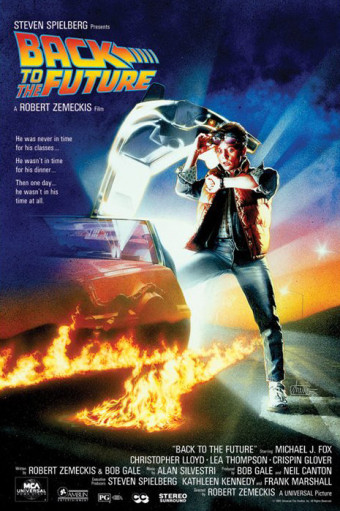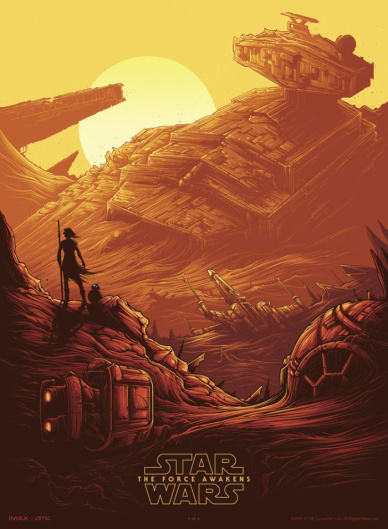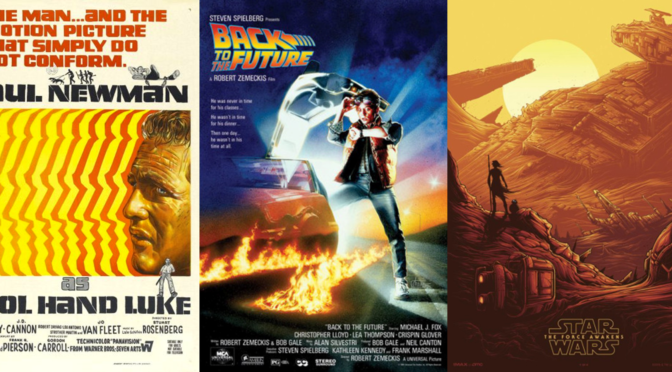Movie posters were once regarded for their artistry. From GONE WITH THE WIND, CASABLANCA to STAR WARS and Indiana Jones, what made a movie poster iconic was its illustrative power. Before social media, teaser trailers and viral marketing the movie poster was singularly the only marketing tool studios had to showcase their films. The success of a film rested entirely on the success of the poster and the word of mouth buzz it would evoke. In the golden age, between the 1930s and the early 1960’s, movie posters relied heavily on movie stars and often used stills from the film to create a storyboard effect to bring the movie to life. Over the years this tradition became less common as movies became less star driven with posters focussing on high concept visuals.
During the seventies movies underwent a revolution as the summer blockbuster changed movie going forever. The likes of JAWS, STAR WARS and CLOSE ENCOUNTERS OF THE THIRD KIND heralded a new age of cinema, one which was distinct from all that had come before. With the advent of this ‘New Hollywood’ came a new approach to marketing. The movie poster went from being a billboard, whereby studios had to cram as much information onto their one-sheets as possible to get audiences into theatres, to becoming something far more sophisticated than that. Once the likes of JAWS, ALIEN and THE EXORCIST had been released the movie poster became an essential marketing tool. Posters appeared more minimal, less fussy, visually striking, with a huge emphasis on taglines and slogans. Instead of movies being sold by their star vehicles, the selling point shifted to advertising movies as products. It was a pop art revolution of marketing and commerce. Post STAR WARS, studios only cared about high-concept motion pictures that could be easily reduced into a compelling visual. The shark on the JAWS poster, the egg on the ALIEN poster, the knife wielding pumpkin hand on the poster for HALLOWEEN all presented a clear image of what these films were which were both thrilling and engaging.

It was horror and science-fiction posters which revolutionised this new era and that influenced the kinds of movies that would dominate the next decade. As the seventies soon became the eighties every film which followed lived in the shadow of George Lucas and Steven Spielberg. Soon a whole new cinema emerged which was youth driven and youth catered. During this era illustrators like Drew Struzan defined the look of an entire generation, creating a style which was highly illustrative, visually grandiose and deeply cinematic. The movie poster became something of profound reverence, the art of the posters often towering over the films themselves. The artistry gave these movies life and captured the scope and spectacle of the films themselves. Struzan’s work being so synonymous with George Lucas and Steven Spielberg captured a certain movie magic which mythologised these iconic images. These posters are etched into our populist cultural consciousness and not only do they embody these films, they evoke the essence and feeling of a time we recall with great affection.

Fast forward to the 21st century and the art of the movie poster has rapidly diminished. As technology has developed and the internet has allowed studios to market films in new and innovative ways, the artistry required for movie posters has become less of a priority. The movie poster has almost become redundant at this point. Most people discover new movies via viral marketing campaigns, teaser trailers and hype garnered from trending articles on social media. The power of the poster as a marketing tool is not what it used to be. In the modern era, we have come to expect shoddy, superimposed, digitally composited posters which are gaudy, clumsy and unattractive. They do not need to sell the movie to you anymore, posters merely act as a visual presence which remind us the movie exists. As long as they are visible at bus stops, billboards and on the sides of busses, the actual artistic quality is no longer essential.
However, the declining artistry of modern movie posters has given way for a whole new subculture to emerge – fan art. Fan art is now incredibly popular and has given a new lease of life to movie art. Social media platforms like Instagram and artist driven sites like Etsy have established a new culture which fulfils the fan desire for artistry in limited edition and exclusive prints, posters and artwork. The rise of alternate posters has become increasingly prominent in the social media age, not only have fan made posters become hugely popular they are often eclipsing the theatrical one sheets and becoming just as iconic as the official artwork.

Sites like Mondo have catered to a die-hard community of movie fans in recent years, their exclusive alternate movie posters created by a community of talented artists have now been published in a coffee table book and garnered much acclaim and widespread attention online. Most significantly is London based artist Dan Mumford. His distinct and vivid pop art was once the hallmark of the underground punk scene in the UK but has gone on to become one of the most in demand and prominent artists producing alternate posters for major Hollywood studios. He created artwork for four exclusive cinema only collectable posters for both STAR WARS: THE FORCE AWAKENS and THE LAST JEDI.
The undeniable popularity and continuing rise of fan driven movie art signals a hunger for illustration and artistry to return to the movie one-sheet. Movie posters used to function as a marketing tool but they also existed as a thing of profound beauty and artistry, something permanent and timeless. An artefact which constituted great cultural importance to be celebrated and revered. As the prominence of great movie art has all but vanished from movie theatres and billboards, it’s fantastic that this art form has found a new home and life in the fan base communities, where it belonged all along.
Peter Thompson is a freelance film writer who writes for TAKE ONE and other outlets. More of his work can be found at his personal website.


Really interesting, and love the Cool Hand Luke poster